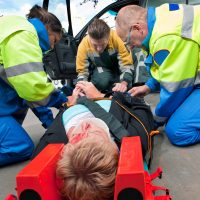Common Car Accident Injury Symptoms

Crashing your car is a jarring experience. You may be dazed, confused, and even frightened. If you were struck by a negligent driver, it’s important to keep your wits about you in order to ensure that any injuries you may have are not made worse by delaying medical treatment. After a car accident, see a doctor to ensure your health and wellbeing are protected. Watch out for symptoms of any of the most common injuries associated with traffic accidents. Read on for a discussion of those common injuries and the symptoms they present. Call an experienced Southern California auto accident lawyer for advice and assistance after a car crash in Los Angeles, Orange County, or the surrounding areas.
Traumatic Brain Injury
One of the most common injuries in car accidents can also be one of the most dangerous. Many car accident victims suffer from a blow to the head, against a seat back, steering wheel, the console, or even an inflated airbag. Airbags are less harmful than concrete or the steering wheel, but they are still extremely firm at the moment of impact.
Traumatic brain injury (TBI) occurs when a person suffers a blow to the head that causes the brain to rattle around inside the skull. The impact causes the brain to bruise or suffer other physical damage.
Mild TBI, known as a concussion, can be identified through symptoms including headache, nausea or vomiting, fatigue, drowsiness, speech problems, and even sensory problems including blurry vision, tinnitus, and odd tastes or smells. More severe TBIs can also present loss of consciousness, persistent headache and nausea, seizures, pupil dilation, weakness in the extremities, leakage of clear fluid from the nose or ears, loss of coordination, and, in extreme cases, coma or death.
Any driver or vehicle occupant who suffers a blow to the head in a car crash should see a doctor immediately to check for TBI. Leaving a brain injury untreated can cause any injuries to worsen, increasing the chance of a debilitating or permanent problem, or even a life-threatening bleed.
Whiplash
Whiplash injury occurs when a person’s head and torso are flung in opposite directions, sending the head and neck “whipping” back and forth. Car accidents, especially rear-end collisions, often cause whiplash when the car seat pushes the torso forward while the head swings backward. Because of the physics involved in the whipping motion, the head may travel at a much greater speed than either of the vehicles involved in the crash; even a low-speed “fender-bender” can cause whiplash.
The motion causes stress to the neck and cervical spine, potentially causing serious nerve and tissue damage. Sufferers of whiplash may experience chronic pain, numbness, weakness, and other functional limitations. These symptoms may take several hours or even days to arise after a crash. Whiplash may be common, but it can be painful, debilitating, and dangerous. Some experts estimate that as many as 10-15 percent of all people who suffer soft-tissue cervical damage will never make a full recovery.
Broken Bones, Lacerations, and Contusions
Car accidents can cause the body to crash into any number of objects, including the steering wheel, other seats, the console, the windows, and the windshield, as well as hazards outside the vehicle. The impact can cause bones to fracture or break, especially in the hands, wrists, face, and cranium. Accident victims may also experience serious bruising (contusions) and cuts (lacerations), depending upon the impact.
Broken bones, lacerations, and bruising may seem “minor” in comparison to brain damage, but they can easily become much more dangerous if left unexamined and untreated. Broken bones can perforate the skin or internal organs, and cuts can quickly become infected if left untreated. Take every injury seriously and see a doctor after an accident.
Muscle Sprains, Strains, and Tears
Car crashes can cause the body to twist, pull, and contort in unnatural positions. These stressful movements can lead to “soft tissue” damage–damage to nerves, tendons, ligaments, and muscles. Strains, sprains, and tears can present with swelling, pain, tingling, numbness, weakness, and cramping, which can last for weeks or months after an accident. Serious soft-tissue injuries may persist for much longer.
Call Today for Stellar Legal Help With a Car Accident Injury Claim in Los Angeles or Orange County
If you or a loved one was seriously hurt or worse in an automobile accident in Los Angeles or Orange County or the surrounding areas, call Machtinger Law for advice and representation from a dedicated and effective Southern California auto accident attorney.